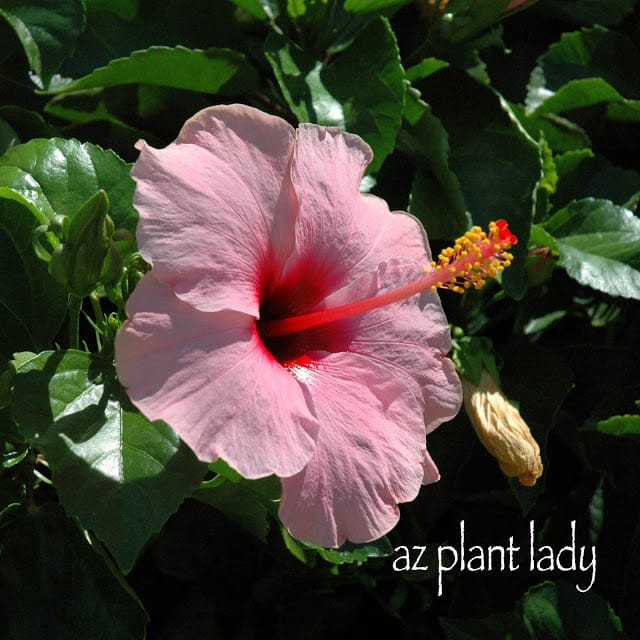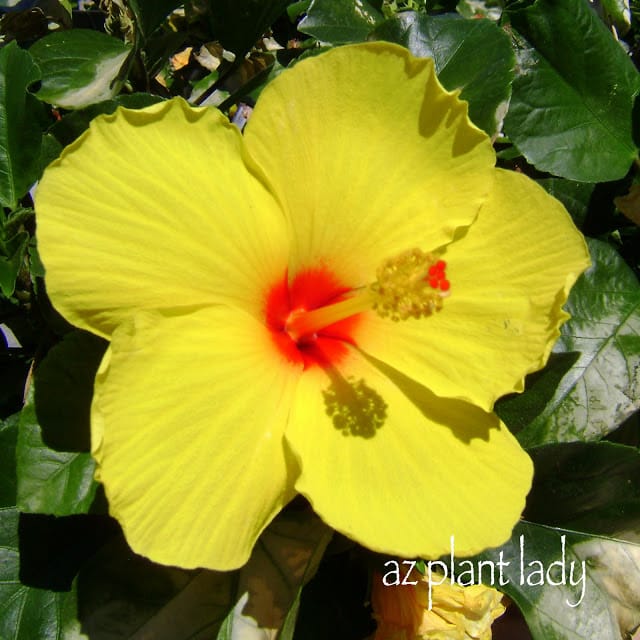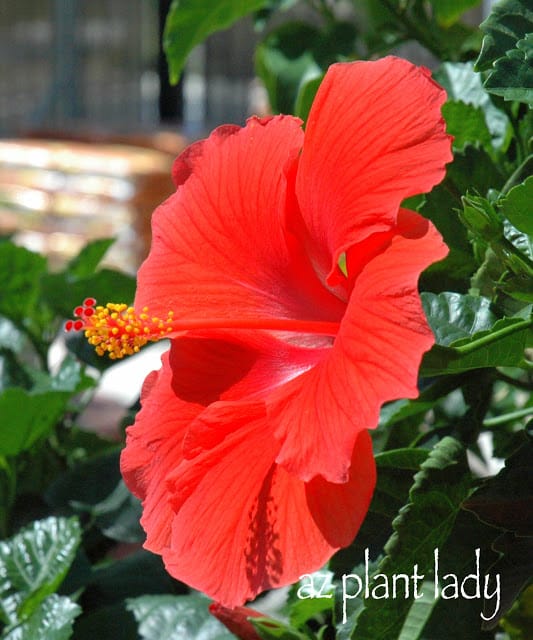Two weeks ago I received a phone call from one of my long-time clients. She was frantic about her Hibiscus plant.
I’m not kidding….
Why was she so upset? Well, she had received this potted Hibiscus from her friend who had grown it for years. She was having a problem with white flies attacking her beloved Hibiscus and it was losing its leaves.
Now, I had seen the Hibiscus last fall, when she had first received it and she proudly showed me where she had put it in her dining room. It had always been grown as an indoor plant.
(All the photos below are of healthy Hibiscus. I didn’t have any photos of unhealthy ones to show you).

Hibiscus plant
It was a lovely specimen of Hibiscus and she was determined to take very good care of her friend’s Hibiscus.
However, when I arrived last week to look at it, it wasn’t looking too happy.
Some of the leaves were yellowing, while some were still green. The Hibiscus had lost many of its leaves. There was also ‘honeydew’ on the leaves, which are shiny, slightly sticky drops. The ‘honeydew’ is actually the ‘poop’ from the white flies.
When I gently brushed the leaves, a cloud of white flies flew upward.

Hibiscus plant
My client had used insecticidal soap and had even carefully brushed each leaf with a soft toothbrush to get “the blasted insects” off.
But, they would always return a few days later. She was at her wit’s end. She said that she couldn’t sleep at night because she kept envisioning ways to “kill those blasted insects”.
So if you have Hibiscus (inside or outside) and have problems with white flies, I will share with you what I told her including one unusual prescription:
1. Spray the leaves (top and bottom), stems and soil surface with insecticidal soap. Do this every 4 days to kill newly emerged white flies before they can lay eggs.
The key to killing white flies with insecticidal soap is that you have to do it 3 – 4 separate times to kill the emerging white flies before they can lay eggs. Insecticidal soap does not kill the eggs, which are usually laid on the soil surface.
2. In conjunction with the insecticidal soap, put out ‘yellow sticky traps’ around your Hibiscus. White flies are attracted to the color yellow and will become ‘stuck’ on the sticky trap. You can buy them at your local nursery, or you can make your own by coloring an index card yellow, attach a popsicle stick on the pack and smear with Vaseline.
3. Neem oil has been shown to be effective as well. But, its effects aren’t obvious at first. It interferes with the life cycle of harmful insects and keeps them from eating, mating and laying eggs. However, Neem oil can be a bit strong for some plants and can damage leaves. So, before using on your entire plant, be sure to apply it to one leaf first and wait 24 hours to see if your plant handles it without damage.
4. Okay, this is my favorite solution. Some people have shown great results in repelling white flies when they incorporate ‘earthworm casings’ into the soil. What are ‘earthworm casings’ you may ask? Well, it is earthworm ‘poop’. Plants just love it and it makes a great soil amendment and many people state that it has kept white flies away from their Hibiscus plants.
**I don’t believe that there are any scientific studies to support this and I haven’t tried it personally. But, earthworm casings will benefit your Hibiscus even if it doesn’t repel white flies, so there is no danger in using it. You can buy earthworm casings online.

Now I generally do not make house calls for a single, indoor plant. But, these clients are a very dear couple and I have had quite a history with them. First, it was attempting to save their old, Magnolia tree. The client had grown up in Louisiana and had loved having a tree that reminded her of her girlhood home.
Sadly, the Magnolia tree died due to an underground leak of the irrigation system. But, the good news is, is that they have a new Magnolia tree that although small, should do very well in its new location.
How about you?
Do you have a tree or plant that is especially important to you?
I would love to hear about it 🙂








